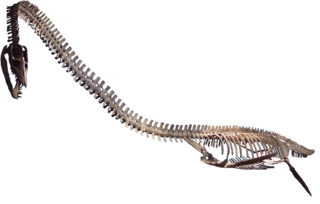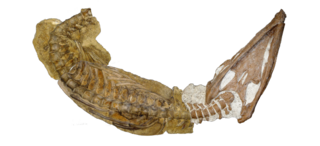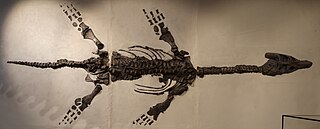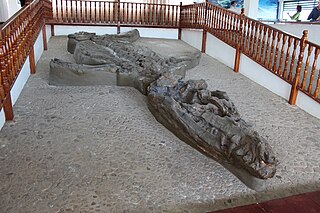
Elasmosaurus is a genus of plesiosaur that lived in North America during the Campanian stage of the Late Cretaceous period, about 80.5 million years ago. The first specimen was discovered in 1867 near Fort Wallace, Kansas, US, and was sent to the American paleontologist Edward Drinker Cope, who named it E. platyurus in 1868. The generic name means "thin-plate reptile", and the specific name means "flat-tailed". Cope originally reconstructed the skeleton of Elasmosaurus with the skull at the end of the tail, an error which was made light of by the paleontologist Othniel Charles Marsh, and became part of their "Bone Wars" rivalry. Only one incomplete Elasmosaurus skeleton is definitely known, consisting of a fragmentary skull, the spine, and the pectoral and pelvic girdles, and a single species is recognized today; other species are now considered invalid or have been moved to other genera.

Kronosaurus is an extinct genus of large short-necked pliosaur Aptian to Albian stages of the Early Cretaceous in what is now Australia. The first known specimen was received in 1899 and consists of a partially preserved mandibular symphysis, which was first thought to come from an ichthyosaur according to Charles De Vis. However, it was 1924 that Albert Heber Longman formally described this specimen as the holotype of an imposing pliosaurid, to which he gave the scientific name K. queenslandicus, which is still the only recognized species nowadays. The genus name, meaning "lizard of Kronos", refers to its large size and possible ferocity reminiscent of the Titan of the Greek mythology, while the species name alludes to Queensland, the Australian state of its discovery. In the early 1930s, the Harvard Museum of Comparative Zoology sent an organized expedition to Australia that recovered two specimens historically attributed to the taxon, including a well known partial skeleton that is now massively restored in plaster. Several attributed fossils were subsequently discovered, including two large, more or less complete skeletons proposed as potential neotypes. Two additional species were proposed, but these are now seen as invalid or belonging to another genus.

The Plesiosauria or plesiosaurs are an order or clade of extinct Mesozoic marine reptiles, belonging to the Sauropterygia.
Peloneustes is a genus of pliosaurid plesiosaur from the Middle Jurassic of England. Its remains are known from the Peterborough Member of the Oxford Clay Formation, which is Callovian in age. It was originally described as a species of Plesiosaurus by palaeontologist Harry Govier Seeley in 1869, before being given its own genus by naturalist Richard Lydekker in 1889. While many species have been assigned to Peloneustes, P. philarchus is currently the only one still considered valid, with the others moved to different genera, considered nomina dubia, or synonymised with P. philarchus. Some of the material formerly assigned to P. evansi have since been reassigned to "Pliosaurus" andrewsi. Peloneustes is known from many specimens, including some very complete material.

Rhomaleosaurus is an extinct genus of Early Jurassic rhomaleosaurid pliosauroid known from Northamptonshire and from Yorkshire of the United Kingdom. It was first named by Harry Seeley in 1874 and the type species is Rhomaleosaurus cramptoni. It was one of the earliest large marine reptile predators which hunted in the seas of Mesozoic era, measuring about 7 metres (23 ft) long. Like other pliosaurs, Rhomaleosaurus fed on ichthyosaurs, ammonites and other plesiosaurs.

Umoonasaurus is an extinct genus of plesiosaur belonging to the family Leptocleididae. This genus lived approximately 115 million years ago during the Early Cretaceous period, in shallow seas covering parts of what is now Australia. It was a relatively small animal around 2.5 metres (8.2 ft) long. An identifying trait of Umoonasaurus is three crest-ridges on its skull.

Dolichorhynchops is an extinct genus of polycotylid plesiosaur from the Late Cretaceous of North America, containing the species D. osborni and D. herschelensis, with two previous species having been assigned to new genera. Specimens of D. osborni have been found in the early Coniacian to early Campanian rocks, while those of D. herschelensis have been found in the late Campanian to early Maastrichtian rocks. Dolichorhynchops was a prehistoric marine reptile. Its Greek generic name means "long-nosed face". While typically measuring about 3 metres (9.8 ft) in length, the largest specimen of D. osborni is estimated to have a total body length more than approximately 4.3 metres (14 ft).

Brachauchenius is an extinct genus of pliosaurid that lived in North America and Morocco during the Late Cretaceous.

Megalneusaurus is an extinct genus of large pliosaurs that lived during the Oxfordian and Kimmeridgian stages of the Late Jurassic in what is now North America. It was provisionally described as a species of Cimoliosaurus by the geologist Wilbur Clinton Knight in 1895, before being given its own genus by the same author in 1898. The only species identified to date is M. rex, known from several specimens identified in the Redwater Shale Member, within the Sundance Formation, Wyoming, United States. A specimen discovered in the Naknek Formation in southern Alaska was referred to the genus in 1994. In Ancient Greek, the generic name literally translates to "large swimming lizard", due to the measurement of the fossils of the holotype specimen.

Hauffiosaurus is an extinct genus of Early Jurassic pliosaurid plesiosaur known from Holzmaden of Germany and from Yorkshire of the United Kingdom. It was first named by Frank Robin O’Keefe in 2001 and the type species is Hauffiosaurus zanoni. In 2011, two additional species were assigned to this genus: H. longirostris and H. tomistomimus.

This timeline of plesiosaur research is a chronologically ordered list of important fossil discoveries, controversies of interpretation, taxonomic revisions, and cultural portrayals of plesiosaurs, an order of marine reptiles that flourished during the Mesozoic Era. The first scientifically documented plesiosaur fossils were discovered during the early 19th century by Mary Anning. Plesiosaurs were actually discovered and described before dinosaurs. They were also among the first animals to be featured in artistic reconstructions of the ancient world, and therefore among the earliest prehistoric creatures to attract the attention of the lay public. Plesiosaurs were originally thought to be a kind of primitive transitional form between marine life and terrestrial reptiles. However, now plesiosaurs are recognized as highly derived marine reptiles descended from terrestrial ancestors.

Megacephalosaurus is an extinct genus of short-necked pliosaur that inhabited the Western Interior Seaway of North America about 94 to 93 million years ago during the Turonian stage of the Late Cretaceous, containing the single species M. eulerti. It is named after its large head, which is the largest of any plesiosaur in the continent and measures up to 1.75 meters (5.7 ft) in length. Megacephalosaurus was one of the largest marine reptiles of its time with an estimated length of 6–9 meters (20–30 ft). Its long snout and consistently sized teeth suggest that it preferred a diet of smaller-sized prey.

Atychodracon is an extinct genus of rhomaleosaurid plesiosaurian known from the Late Triassic - Early Jurassic boundary of England. It contains a single species, Atychodracon megacephalus, named in 1846 originally as a species of Plesiosaurus. The holotype of "P." megacephalus was destroyed during a World War II air raid in 1940 and was later replaced with a neotype. The species had a very unstable taxonomic history, being referred to four different genera by various authors until a new genus name was created for it in 2015. Apart from the destroyed holotype and its three partial casts, a neotype and two additional individuals are currently referred to Atychodracon megacephalus, making it a relatively well represented rhomaleosaurid.
Luskhan is an extinct genus of brachauchenine pliosaur from the Cretaceous of Russia. The type and only species is Luskhan itilensis, named by Valentin Fischer and colleagues in 2017 from a well-preserved and nearly complete skeleton. As an early-diverging brachauchenine, Luskhan consequently exhibits an intermediate combination of traits seen in more basal and more derived pliosaurs. However, Luskhan departs significantly from other pliosaurs in that it exhibits a lack of adaptations in its skull to feeding on large prey; its slender snout, small teeth, and short tooth rows instead indicate a skull adapted for feeding on small, soft prey. With these features, it is the pliosaur that approaches closest to the distantly-related piscivorous polycotylids, having convergently evolved these traits more than 10 million years apart.

William Edward "Bill" Schevill was an American paleontologist famous for his part in dynamiting out the nodules of the most complete skeleton of the short-necked pliosaur Kronosaurus queenslandicus discovered in Hughenden in Queensland, Australia, in 1932. He later became known as an authority on the sounds of whales. Schevill had the title of scientist emeritus at the Woods Hole Oceanographic Institution, where he had begun working in 1943, technically retiring in 1985.

Lagenanectes is a genus of elasmosaurid plesiosaur from the Lower Cretaceous, found in Lower Saxony, Germany. The only species, Lagenanectes richterae, was first described in 2017, and is regarded as one of the best-preserved plesiosaur fossils from this geological age in Europe. Lagenanectes is one of the earliest elasmosaurids. The holotype is an incomplete skeleton, comprising large parts of the skull, some neck and tail vertebrae as well as ribs and part of the limbs. A length of about 8 meters has been estimated.

The Harvard Australian Expedition of 1931–1932 was a six-man venture sent by then Harvard Museum of Comparative Zoology (MCZ) director Thomas Barbour to Australia for the dual purpose of procuring specimens and studying native (living) wildlife in its natural habitat. The Expedition leader was Harvard Professor William Morton Wheeler, with the others being Dr. Philip Jackson Darlington, Jr., Dr. Glover Morrill Allen and his student Ralph Nicholson Ellis, medical officer Dr. Ira M. Dixon, and William E. Schevill . The Expedition was a success, with 341 mammal, 545 amphibian, and thousands of insect specimens returning to the United States., yet its most famous legacy and find was the accidental discovery of the world's most complete skeleton of the short-necked pliosaur Kronosaurus queenslandicus.

Sachicasaurus is an extinct genus of brachauchenine pliosaurid known from the Barremian of the Paja Formation, Altiplano Cundiboyacense in the Colombian Eastern Ranges of the Andes. The type species is S. vitae.
The Bulldog Shale is a formation of Early Cretaceous age that forms part of the Marree Subgroup of the Rolling Downs Group, located in the Eromanga Basin of South Australia, Queensland and New South Wales.

Monquirasaurus is an extinct genus of giant short-necked pliosaurs who lived during the Early Cretaceous (Aptian) in what is now Colombia. One species is known, M. boyacensis, described in 2021 from an almost complete fossil skeleton, discovered in 1977 in the town of Villa de Leyva, located in Boyacá. Published descriptions of the holotype specimen estimate that it should reach a total size approaching 8 m (26 ft) in length, making Monquirasaurus a large representative of the pliosaurids.


























